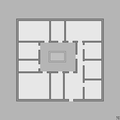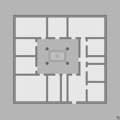Atrium (architecture)
In Roman architecture, the atrium was a central space in a house (often a residential building); it was widespread in the Roman Empire .
The atrium is a rectangular interior space in the center of the house from which the surrounding rooms are accessible. It served as a common room for the family. The atrium received light through an opening in the roof. The boundaries between atrium and inner courtyard are fluid.
Etymology and meaning
The term atrium may come from the Latin ater , which means something like blackened with smoke. In the room there was originally the hearth , consisting of an open hearth , which blackened the ceiling. The room served as a dining room, work room for the women and lounge for the residents.
In Christian basilicas , atrium, together with the term peristyle, denotes the forecourt.
Nowadays the term atrium is also used for different variants of the inner courtyard in modern buildings. Atriums in public buildings are often closed with a glass roof.
Designs

Vitruvius mentions a total of five designs, which can be divided into atriums with and without a roof opening. The atrium testudinatum - probably from the Latin word for turtle testudo - should be cited as the atrium without an opening, probably the older design . The other four forms are atria with an opening; they differ in the type of construction.
In the pillar-less construction method described by Vitruvius (6, 3, 1) as atrium tuscanicum (Etruscan atrium), the roof is supported by two massive wooden beams, on which two more beams are embedded across. This resulted in an interior that was partially open at the top, the roof of which was supported by columns or pillars. The atrium with only four columns is called atrium tetrastylicum (four-column atrium), the atrium with an opening supported by many columns is called atrium corinthicum (Corinthian atrium).
Despite the expensive beam construction, the atrium tuscanicum was the most widespread because it allowed a clear view from the entrance to the tablinum or later to the peristyle .
Roofing
The roof was mostly designed in the form of an atrium impluviatum with an inward sloping roof slope. Under the resulting rectangular roof opening, the Compluvium , there was also a rectangular water basin, the Impluvium , which was used to collect the rainwater that was directed into a cistern . If the atrium was not used to collect rainwater at the same time, the roof could slope outwards; in this case it is called the atrium displuviatum . According to Vitruvius, this had the disadvantage that the vertical gutters (lat. Fistula ) often could not absorb the rainwater from the horizontal gutters (lat. Canalis ) and so the water flowed down the walls, which were damaged as a result.
In smaller houses there were also completely covered atria without a compluvium, these were called atrium testudinatum .
Atrium in the church building
While the atrium was in the center of residential buildings, an arcade courtyard in front of the west portal is known as the atrium in church buildings.
See also
- Atrium house - to comparable house types in different cultures
- Courtyard (architecture) - to the atrium in modern architecture
- Cloister - courtyard in Christian monasteries, similar to an atrium
- Patio - courtyard in Spain and Portugal
literature
- August Mau : atrium . In: Paulys Realencyclopadie der classischen Antiquity Science (RE). Volume II, 2, Stuttgart 1896, Col. 2146-2148.
Web links
- The Italian House ( Memento of May 31, 2009 in the Internet Archive )





